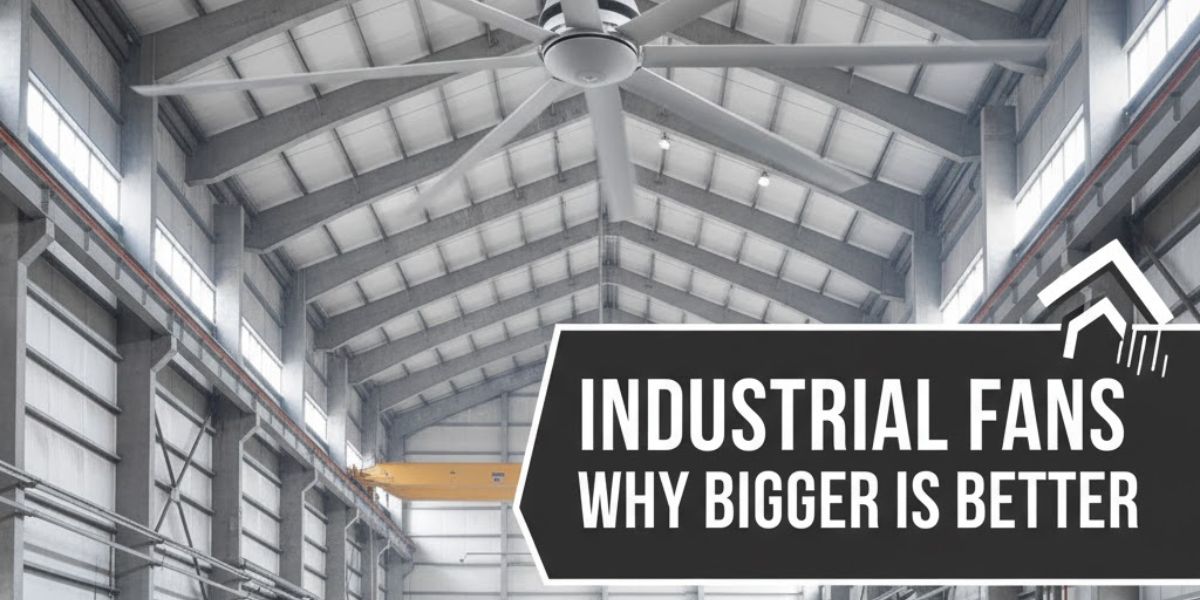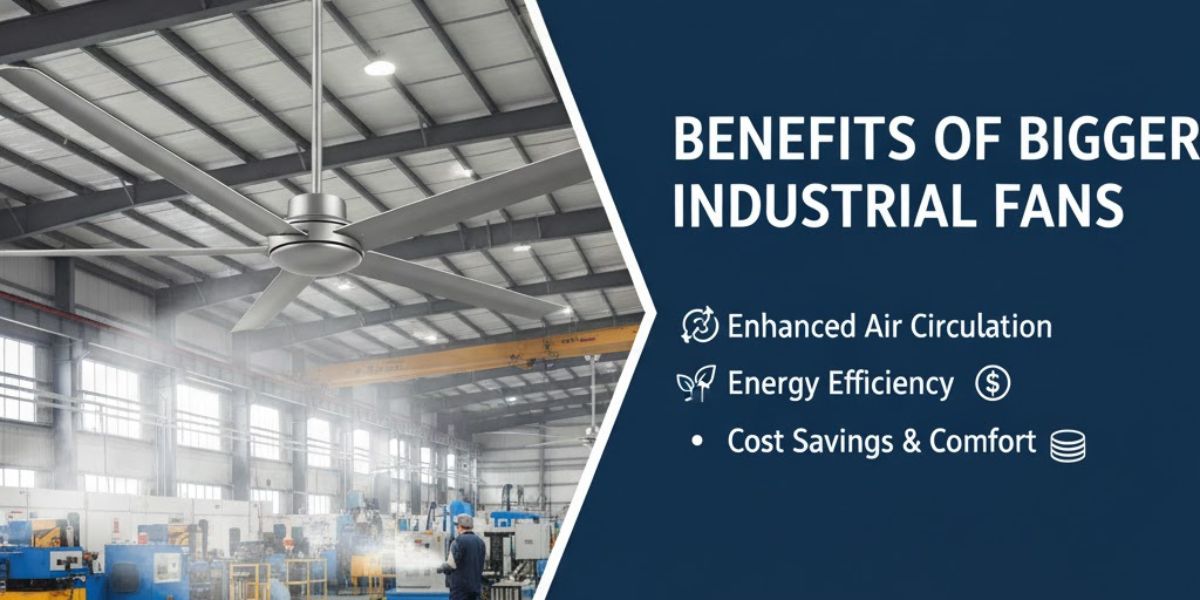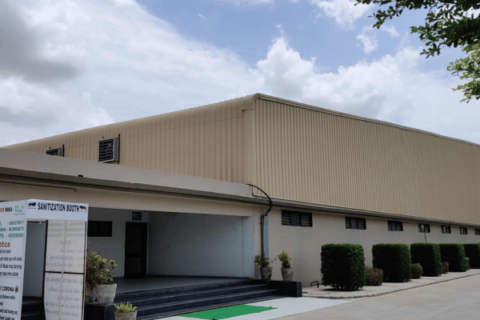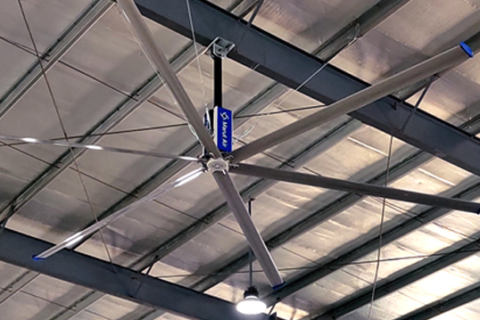Keeping the air fresh and comfortable in large spaces like factories, warehouses, and workshops is no easy task. With heavy machinery running for hours and limited natural airflow, these environments can quickly become hot and stuffy. That’s where industrial fans come in as a simple yet highly effective solution for maintaining proper air circulation. Industrial fans are designed to keep large spaces comfortable and safe by maintaining consistent air circulation. Thus, it is a better option to buy a bigger industrial fan. They help move fresh air across wide areas, reduce heat buildup, and improve overall air quality.
According to Grand View Research, the global market of bigger industrial fans is projected to reach US$9,563.8 million by 2030, growing at a CAGR of 4.8% from 2025 to 2030.
Whether it’s a factory floor, workshop, or warehouse, proper airflow is crucial for both worker comfort and equipment efficiency. In this blog, we’ll break down why bigger industrial fans are better, how they work, and their benefits in maintaining healthy air circulation in big spaces.
Let’s Examine Why Industrial Big Fans Are Important

An industrial big fan tends to form an important aspect associated with commercial and industrial spaces. These help regulate the flow of air and impact temperature control. There happens to be a range of options available when it comes to choosing the right fan. However, it is important to ensure that the equipment is reliable as well as powerful. And carries out the required task efficiently. In various cases, it has been observed that an industrial big fan tends to perform better compared to the other options.
Know more about HVLS fans
HVLS fans are essentially huge ceiling fans with propellers that are several feet long. These are attached to the ceiling. They can provide extensive low-speed air circulation. These are quite helpful because they help produce enormous columns of air and push through stagnant conditions.
- It contributes to the efficient circulation of large volumes of air while requiring little electricity to function.
- These are comparatively more efficient than regular fans because of the fluid dynamics involved.
- High-velocity air movement by small fans requires more energy.
- However, HVLS fans generate less resistance. They use little energy while producing an increased impact.
Why is it important?
An industrial big fan essentially creates the required movement of air to keep up with much-needed circulation. It can lower the overall costs and be effective in spaces such as the automobile industry, warehouses, shopping, and much more. They keep the environment cool and comfortable and improve their air quality. The cost-effective approach and increased safety are added bonuses.
| Reason | Explanation |
| Efficient Airflow | Large fans move a high volume of air, ventilating big spaces quickly and effectively. |
| Energy Savings | Bigger fans can operate at lower speeds while providing the same airflow, reducing electricity consumption. |
| Temperature Control | Helps maintain stable indoor temperatures, removing hot spots and improving comfort for workers. |
| Improved Air Quality | Removes dust, fumes, smoke, and airborne contaminants, creating a healthier workspace. |
| Noise Reduction | Operates slower than multiple smaller fans, often producing less noise. |
| Cost-Effective | Fewer large fans can replace several small fans, lowering installation and maintenance costs. |
| Enhanced Productivity & Safety | Better ventilation improves worker comfort, health, and safety, boosting productivity. |
| Sustainability | Energy-efficient operation contributes to a lower carbon footprint and greener operations. |
Benefits of Buying Bigger Industrial Fans
Let’s look at the benefits of bigger industrial HVLS fans.
Greater Airflow
The most obvious advantage of industrial fans of large size is that they can move more air than smaller fans. This can be crucial in large industrial spaces where huge airflow is required to keep workers comfortable and maintain optimal production conditions. In addition, bigger fans can move larger volumes of air, which can help improve the air quality in the space. Finally, industrial ceiling fans are essential in industrial environments where there may be hazardous materials present.
More Efficient Cooling
Bigger industrial ceiling fans are also more efficient at cooling large spaces. Because they can move more air, they can dissipate heat more quickly and effectively. This can help keep workers comfortable and increase productivity. In addition, the larger the fan, the more air it can circulate, which can help cool the entire space more effectively. It is essential in our North American climate, where the temperature can be scorching during the summer months. Industrial fans play a crucial role in keeping the working environment cool and comfortable.
Improved Air Quality
Bigger industrial ceiling fans can also help improve air quality by circulating fresh air throughout the space and removing smoke and fumes. They can also help reduce harmful pollutants and improve the air quality in the room: better air quality can also help to improve workers’ productivity by reducing the risk of absenteeism due to health issues. Workers are more likely to be productive and engaged when they are healthy and comfortable.
Cost-Effective
While industrial fans may have a higher initial cost, they can be more cost-effective in the long run. Because they are more efficient at moving air and cooling large spaces, they can help reduce energy costs. The energy savings that come with using a large industrial fan can offset the fan’s initial cost over time. Additionally, bigger industrial ceiling fans are more durable, making them less likely to break down and require costly repairs or replacements. This can save you money in the long run as you won’t have to replace the fan as often.

Increased Safety
Increased safety is one of the key benefits of using larger industrial ceiling fans. By circulating air more effectively, these fans can help to reduce the build-up of combustible gases in space. This is particularly important in industrial settings where there may be a fire risk due to flammable materials or gases. Proper ventilation is crucial for reducing the concentration of combustible gases and vapours in the air. In addition, industrial fans can move more air and increase the air exchange rate, which can help reduce the fire risk.
Versatility
Bigger industrial ceiling fans offer more versatility in terms of their usage. You can use them in various settings, such as warehouses, manufacturing plants, and other large industrial spaces. They can also be used in environments requiring specialized ventilation, such as removing smoke and fumes in industrial environments. In addition, their large diameter allows them to move a large amount of air, which is essential in the case of emergency ventilation.
Quieter Work Environment
A quieter work environment is a significant benefit of using larger industrial fans. Smaller, high-speed fans can generate a substantial amount of noise, distracting workers and making it difficult for them to concentrate on their tasks. In contrast, a large industrial fan is designed to run at a slower speed, which can make it much quieter when it is in operation.
Conclusion
Industrial big fans find extensive usage in a lot of spaces. They offer numerous benefits and are well-suited to ensure proper ventilation. Investing in a big fan is one of the better approaches to ensuring proper circulation of air and the creation of conditions suitable for working.
If you’re looking for reliable HVLS fans, rely on Marut Air‘s extensive ventilation solutions. They provide high-quality equipment, catering to market standards and surpassing them. They have created quite a name. Visit their website to learn more about the equipment or get in touch with them, for they value consumer satisfaction significantly.
Frequently Asked Questions
1. Why are bigger industrial fans considered more efficient?
Larger industrial fans move a higher volume of air while using less energy per cubic foot compared to smaller fans. This means they can ventilate or cool large spaces more efficiently and at a lower operating cost.
2. Do bigger fans help reduce energy consumption?
Yes. Bigger fans typically run at lower speeds while still delivering strong airflow. This reduces electricity use and lowers the overall energy load on cooling or ventilation systems.
3. Can large industrial fans improve airflow in big facilities?
Absolutely. Their wide blade span allows air to circulate more effectively across long distances, making them ideal for warehouses, factories, workshops, and large commercial spaces.
4. Are bigger fans noisier than smaller ones?
Surprisingly, no. Because bigger fans operate at lower speeds, they often produce less noise than smaller fans that must rotate faster to move the same amount of air.
5. Do large fans help maintain stable indoor temperatures?
Yes. They help distribute air evenly throughout the space, preventing hot or cold spots and keeping temperatures stable across the entire facility.





